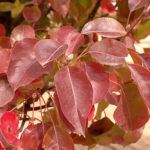The rise and fall of Asian Pear

We do this all the time!
We over use, we abuse, we’re in a hurry, and we’re lazy! The landscape/nursery industry is a repeat offender! We have our “go-to,” easy-money plants. On the surface that doesn’t seem to be a bad thing. Almost every contractor has their favorite group of plants; almost every contractor is stuck in some sort of rut! Week after week we get the same list from contractors. Only the numbers change!
Need proof? Recent history provides great examples! Let’s start with the Green Ash. (I hope you don’t need an explanation!) Another great example is the Norway Maple. Our storage field used to have hundreds of Norways of many varieties. It’s “go-to-ness” turned it into an invasive species banned from most cities due to its ability to reseed into alleys and easement areas. The resulting offspring were often not very landscape worthy. Tree growers were left with fields of trees with no market in which to sell them!

Pear in our tree field in 2014
Looming on the horizon is the fate of the beloved Callery Pear. The Bradford Pear’s (a.k.a. “Banana-Split Pear”) popularity succumbed to the hyper-popular Cleveland Pear. It’s been the near-perfect tree: Popular, household recognition! Transplanting into most any soil, great form, great bloom quality, and rich, long-lasting fall color!

The overuse of this species has led to outbreaks of Pear Rust, and its ability to reseed has begun to clog open spaces with again undesirable offspring. States and cities have begun restricting its usage. And then there’s probable, correcting fireblight….
What’s next? Will growers develop a truly seedless Callery? Or, what will be the new big seller? Haven’t we learned anything? We don’t need another “go-to” plant. This industry needs good practices and diversity!
We already offer a number of trees that would substitute well for the Cleveland Pear. Some of these are:
- Acer rubrum ‘Brandywine’
- Acer saccharum ‘Legacy’

Acer rubrum 'Brandywine' (L) - Acer saccharum 'Legacy' (R)
- Acer x freemanii Armstrong’
- Amelanchier laevis ‘Cumulus’
- Carpinus caroliniana

Carpinus caroliniana - American Hornbeam
- Cornus mas ‘Golden Glory’
- Ostrya virginiana
- Syringa reticulata ‘Ivory Silk’

Cornus mas 'Golden Glory' (L) - Syringa reticulata 'Ivory Silk' (R)
- Taxodium distichum ‘Shawnee Brave’

Taxodium distichum 'Shawnee Brave'
Resist the temptation, don’t be a repeat offender! Mix it up out there!
